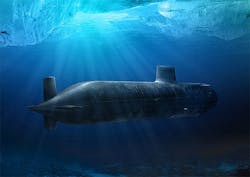Navy looks for companies able to build optical communications between aircraft and submarines
Officials of the Space and Naval Warfare Systems Command (SPAWAR) in San Diego issued a sources-sought notice (SPAWAR_Headquarters_MKTSVY_131EDE) last week for the Modular Optical Communications (OCOMMS) Payloads project, which seeks to design a communications system to provide optimal connectivity between submarines and aircraft.
Optical communications links would be better than radio waves for this application because optical offers sufficient attenuation to penetrate water to undersea systems at useful depths, while RF systems require an above water antenna, officials say.
Communications through such an air-water-interface (AWI) have the potential for very high data rates and inherently low probability of intercept and low probability of detection (LPI/LPD). Navy researchers are looking for technology tradeoffs between bandwidth, availability, and vulnerability for such an optical communications payload.
Navy researchers have in mind an optical communications system that can communicate at speeds no slower than 1 kilobit per second between a submersible and an aircraft at ranges farther than 15 nautical miles through the air, and to depths greater than 100 feet through the water.
Related: DARPA pushes submarine laser communications technology for ASW operations
Of primary interest is an over-the-air and through-the-water optical communications system packaged as a gimbal mounted to the aircraft or in a pod that measures no larger than 16.5 inches long, 15.5 inches side, and 13.25 inches high, and that weighs no more than 60 pounds.
Technologies of interest include compact pulsed lasers operating in the 450-to-550-nanometer region, large-aperture narrow-bandwidth and wide-field-of-view optical filters, communications modems able to modulate and demodulate optical signals using pulse position modulation (PPM), and sensitive large-aperture optical detectors.
The modem will use Reed-Solomon encoding to improve bit error rate (BER) performance, and should be able to monitor SNR and BER or Symbol Error Rate (SER) to adjust the modem parameters of the uplink and downlink to make the most of communications bandwidth while optimizing BER performance.
Companies should email white papers no longer than 22 pages to SPAWAR's Kathleen McCoy no later than 10 March 2017 at [email protected].
Email questions to Kathleen McCoy at [email protected]. More information is online at https://www.fbo.gov/spg/DON/SPAWAR/SPAWARHQ/SPAWAR_Headquarters_MKTSVY_131EDE/listing.html.
Learn more: search the Aerospace & Defense Buyer's Guide for companies, new products, press releases, and videos
